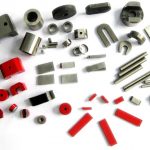How to Choose The Right Magnet
Apex alone offers 450 different types of magnets – and each geometric variant has unique benefits, so how are you to choose? The truth is, many magnets can be used for many things — isn’t that what makes them so great? With that said, we can offer some guidance to help you in your decision for you to get the most bang for your buck and offer you the easiest application.
Choosing Your Shape and Material
In our opinion, the shape and material are often overlooked when choosing the right magnet for your project. The shape of a magnet can tell you a lot more than size! Each magnet’s shape determines how the magnetic field lines are arranged outside of the magnet as well as the strength of its pull. Shape determines what surface area it covers — think about using a sphere magnet to hang something up — technically spheres are the strongest magnet relative to their size/shape, but they don’t have a large contact point. Instead, cylinders or cubes are a better choice for hanging things. Check out this guide we made on the different shape options and their uses!
NdFeB, SmCo, Alnico... these aren’t for a word scramble! Each of these are a type of magnet — with an additional two as well. As you can probably guess, each type has their own strengths, weaknesses, and uses! If you need a magnet, start with this guide first. Of course, neodymium magnets are a best seller here at Apex for a reason — they’re available in a number of basic shapes, such as cubes, spheres and cylinders, bars, blocks, discs and rings, and so many more!
Pullforce and Strength
Bigger is not always better! That goes for shape, pull force, and price tag! A magnet with the same strength/pull force as another can be more expensive—a direct result of their shape and weight. Pull force and magnet strength can often be confused, so we made this guide to help you choose between pull forces. The pull force of a magnet is essentially the force needed to pull two magnets apart or to remove a magnet from some other surface. For example, a magnet with a 15lb pull force does not necessarily mean it will be able to lift a 15lb object.
It’s important to remember, pull strength is a very subjective measure that is dependent upon many factors such as:
- Type of material being pulled against
- Surface conditions
- Physical contact
- Magnet characteristics such as plating composition
- Presence or absence of lateral and rotational forces

